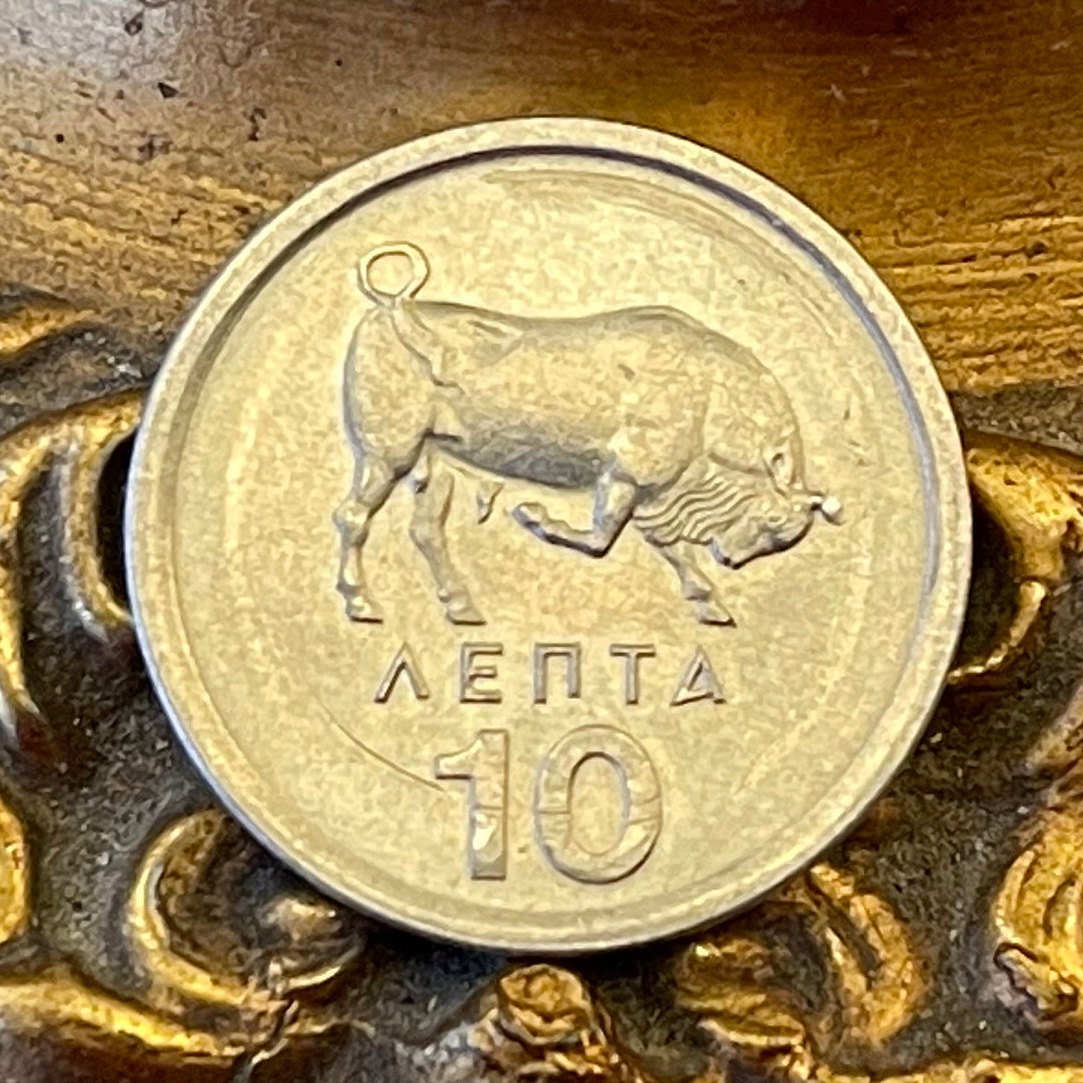elemintalshop
Charging Bull 10 Lepta Greece Authentic Coin Money for Jewelry and Craft Making (Taurus) (Bull-leaping) (Minoan Fresco) (Taureador Frescoes)
Charging Bull 10 Lepta Greece Authentic Coin Money for Jewelry and Craft Making (Taurus) (Bull-leaping) (Minoan Fresco) (Taureador Frescoes)
Couldn't load pickup availability
Charging Bull 10 Lepta Greece Authentic Coin Money for Jewelry and Craft Making (Taurus) (Bull-leaping) (Minoan Fresco) (Taureador Frescoes)
Obverse: The National Emblem of Greece, which consists of a blue escutcheon with a white cross totally surrounded by two laurel branches.
Lettering: ΕΛΛΗΝΙΚΗ ΔΗΜΟΚΡΑΤΙΑ
Translation: HELLENIC REPUBLIC
Reverse: A charging bull looking right, denomination below.
Lettering: ΛΕΠΤΑ 10
Translation: LEPTA 10
Features
Issuer Greece
Period Third Hellenic Republic (1974-date)
Type Standard circulation coin
Years 1976-1978
Value 10 Lepta (0.1 GRD)
Currency Third modern drachma (1954-2001)
Composition Aluminium
Weight 1.1 g
Diameter 20 mm
Shape Round
Orientation Medal alignment ↑↑
Demonetized Yes
Number N# 531
References KM# 113, Schön# 56
Wikipedia:
Bull-leaping is thought to have been a key ritual in the religion of the Minoan civilization in Bronze Age Crete. As in the case of other Mediterranean civilizations, the bull was the subject of veneration and worship. Representation of the Bull at the palace of Knossos is a widespread symbol in the art and decoration of this archaeological site.
The assumption, widely debated by scholars, is that the iconography represents a ritual sport and/or performance in which human athletes—both male and female—literally vaulted over bulls as part of a ceremonial rite. This ritual is hypothesized to have consisted of an acrobatic leap over a bull, such that when the leaper grasped the bull's horns, the bull would violently jerk its neck upwards, giving the leaper the momentum necessary to perform somersaults and other acrobatic tricks or stunts.
Barbara Olsen, associate professor of Greek and Roman Studies at Vassar College, adds that the sport was probably not especially dangerous for participants. "From the images it looks like they [leaped over the bulls] successfully—the Minoans tend not to give us too much violent imagery, so the bull-leaping usually ends pretty well," but the goring scene on the "boxer's rhyton" found in Hagia Triada suggests that injuries were not unknown.
*****
Wikipedia:
Arthur Evans recognized that depictions of bulls and bull-handling had a long tradition represented by copious instances in multi-media art, not only at Knossos, and other sites on Crete, but also in the Aegean and on mainland Greece, with a tradition even more ancient in Egypt and the Middle East. At Knossos he distinguished between "bull-grappling scenes" or "'cow-boy' feats in the open" and "Circus Sports." The cowboy scenes depict the catching and handling of wild cattle, represented by animal icons very like the aurochs from which kine were domesticated. This type of cattle motif is shown on the stucco fresco in the North Entrance of the palace. Additionally, Jordan Wolfe, of Furman University, explains how the act of bull-leaping is especially significant to Minoan culture because it highlights man's dubious mastery of nature.
The Circus Sports are to be contrasted to bull-catching. They are "a more structurally organized and ceremonial form of the sport confined, of its very nature, to a specially devised structure." He goes on to conjecture, "the Palace Bull-Ring itself lay on the river flat immediately below." The Taureador Frescoes, then, are not depictions of real events in real time, but are decorative motifs on the wall above a ceremonial bull-ring. They depict a stock scene, of a conventional nature, which has come to be termed "bull-leaping." It still has no viable definition. Although it vaguely brings to mind the act of jumping over bulls, the technique and the reasons for doing that remain obscure, a century after the discovery of the frescos.
Modern attempts to recreate the leaping on modern cattle have resulted only in a number of deaths. In short, the bull is too fast, too powerful and too aggressive to allow seizure of the horns, much less the use of the energy of the neck toss for acrobatics. Moreover, that toss is a hook to the side, not a neat backward boost. The bull attempts to skewer the human with one horn, without a view toward the style of the frescos. It is possible to leap over small bulls without touching them, even as they charge, and such spectacles still practiced in France may be the ultimate source of the icon. A stationary bull might be touched or pushed on the way over, but pressing on a bull in motion would have the same effect as being sideswiped by a speeding vehicle; that is, tumbling out of control.
The Taureador Frescoes are not frauds or incorrect reconstructions. The same bull-leaping scene appears in miniature in sealings and sealstones of the MM and LM periods. Explanations and classifications of the figures depicted are strictly theoretical, never illustrated by real-life examples. The only certain perception is that the leaper goes over the bull in an upside-down position, whether diving from above, leaping up from below, or with or without the assistance of another human or a device such as a pole. Why he should choose to do so also is strictly theoretical, although motives may probably presumed to be similar to those of modern adolescents in France: adventure and peer status. It would have to be, certainly, a volunteer activity of some social reward.
Share










Exactly what I wanted and expected
it is great coin for my 24k gold gold coin.









